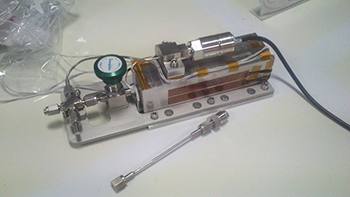
H2 Energy Storage Unit Operating in the 15-20 K temperature range
The ATHENA satellite will employ a complex cryogenic chain for X-Ray detector cooling down to 50 mK. To absorb the heat peaks released periodically during the recycling stages of a 300 mK cooler, an Energy Storage Unit (ESU) using liquid hydrogen has been developed and absorbs 400 J of thermal energy in 30 min between 15 K and 16 K by taking advantage of the liquid-to-vapour latent heat of hydrogen in a closed system. The ESU is composed of a low temperature liquid hydrogen reservoir, two intermediate interfaces for gas pre- cooling and a hydrogen gas storage vessel at room temperature. This vessel can either be a 56-litre expansion volume (for ground testing) or a canister filled with a metal hydride, LaNi4.8Sn0.2 that chemically absorbs hydrogen in its atomic form. The latter largely reduces the volume of the vessel and enables working at near-constant pressure and temperature.
Two devices have been developed for this project: a Development Model, a breadboard device used for preliminary testing, and the Engineering Model, the final model of the ESU delivered to ESA and subject to severe mechanical testing in order to comply with strict requirements. Both models were able to store 400 J with a temperature increase of 2 K when a 56-litre expansion volume is used, while results using metal hydrides show that the same heat load can be absorbed between 15 K to 16.5 K, where the cold cell temperature is above 16 K for less than 10 min. Full regeneration of the ESU can be achieved in under 24 h without exceeding the cooling power available at the different temperature stages.
Funding
500 k€
Project responsible

Grégoire Bonfait
gb@fct.unl.pt

